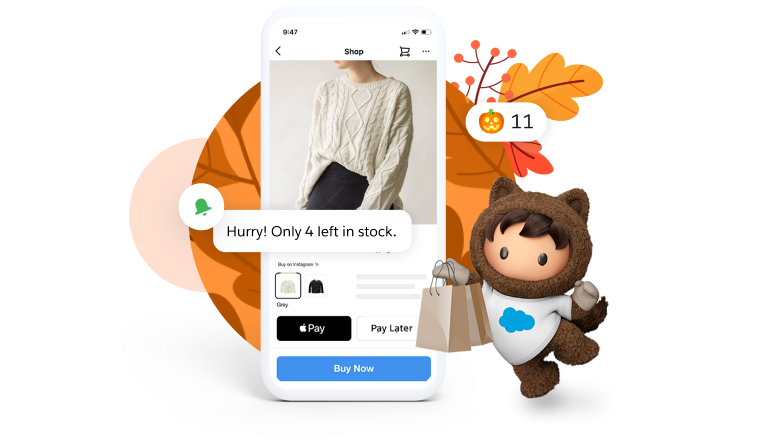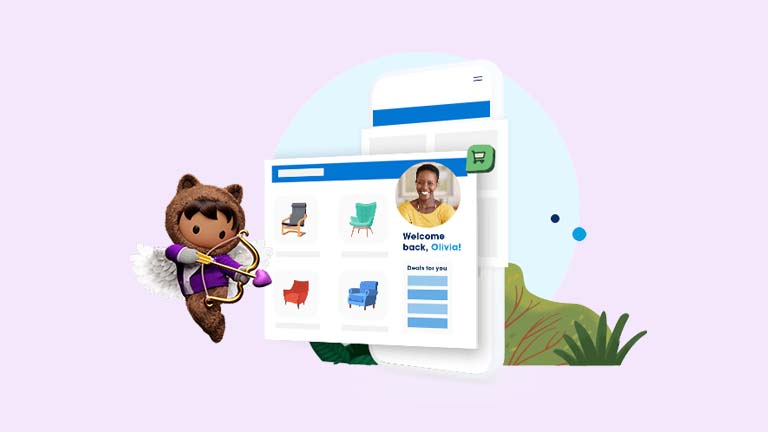The 2022 Holiday Planning Guide for Retailers
Inflation, supply problems, and labor shortages can’t keep you down. Here’s how to deliver holiday happiness and revenue all year round.
– Rob Garf, VP and GM, Retail at Salesforce
As companies try to drive profitable growth by optimising their promotional calendars, they’re asking one question: How can we attract new shoppers and keep existing customers coming back for more? This year, retailers will focus on developing data acquisition strategies, bridging the physical-digital divide, and building stronger business partnerships. But on a larger scale, they’ll need to put as much investment into the post-purchase experience as they do the path-to-purchase, pairing test-and-learn strategies with proven revenue drivers like flash sales and special promotions.
Here we share the insights and strategies you’ll need to prepare for your peak demand events, from the holiday shopping season to door-busting special events.
Chapter 1: Activate data to acquire and engage loyal customers.
Customer data is the fuel that ignites loyalty — and growth.

Exclusive experiences drive loyalty.

– Connected Shoppers Report, Fourth Edition, Salesforce, 2021
This looks like:
- Early access: Giving members the chance to shop Black Friday deals before Black Friday ensures they have access to products that are likely to sell out (while avoiding crowds, too).
- Free expedited shipping: Nothing says stress like realising you’ve forgotten a gift when the holiday is two days away. Help members be holiday heroes with complimentary overnight shipping so they save time and money.
- Exclusive events and products: Keep it festive online and in-store with a members-only holiday shopping party that includes a trunk show, limited edition products, or one-night-only deals. Consider online waiting rooms for blowout digital events.
- Gamification: Stay top-of-mind (and keep them coming back) by rewarding members for taking actions beyond transactions. That could be earning badges for downloading an app or leaving a product review.
- A net zero focus: 78% of customers say environmental practices influence their decision to buy from a company, so look for retailers to reward loyalty members when they engage in environmentally friendly behaviours. At Starbucks, for example, loyalty members earn points when they buy with reusable cups. And at Kiehl’s, customers who bring empty containers back to the store earn rewards.
Test the waters in the metaverse.
The metaverse is among the most exciting ecommerce innovations, and shoppers are riding the trend: This year, 49% of shoppers said they would purchase non-fungible tokens (NFTs), a digital asset that represents something unique or scarce stored on a blockchain. Whether that looks like a virtual version of a real-world item or a digital collectible, 47% of shoppers said that the appeal of gifting an NFT is that they want to give a gift that might increase in value. Even more interesting is that 42% said they would be more likely to buy a physical product if it came with a digital twin.
NFTs aren’t the only way to play in the metaverse, however. Look no further than online gaming, where players buy digital skins to give their avatars a unique look. The market for virtual clothing, accessories, and cosmetic add-ons is impressive: In fact, digital skins account for an estimated $40 billion per year. Even fashion brands are getting in on the action, with one high-end retailer leading the way with a winter-themed digital world where visitors could try on, buy, and wear apparel — only online, of course.
Connect customer data.
The average retailer uses 44 different systems to engage with customers across digital and physical touchpoints. If you’re wondering why that matters, put yourself in the place of a time-starved holiday shopper who has repeated her question to three different customer service agents. Shoppers feel the disconnect caused by internal data silos: In fact, 54% of customers say it feels like sales, service, and marketing don’t share information.
The pressure is on retailers to deliver the personal and consistent experiences you want your brand to represent. Companies that do this well unify customer profile data across channels, from social media to stores, enabling efficiency. Employees from any department can view data in real time on one screen. Communications stay up-to-date and accurate, avoiding repetition, no matter how a customer chooses to interact.
Operationalise data and intelligence.

– State of Marketing, Seventh Edition, Salesforce, 2021
Here’s why: Retailers that do this well are able to anticipate their customers’ needs and preferences — removing friction during a busy time of year. Using data to personalise shopping journeys makes it easier for customers to find the products they want and check out with the payment options they prefer. This looks like:
- Customised site search and product sort: Embed AI into search dictionaries to surface the most relevant term and customise the order in which they appear based on behavioural and customer data. That makes it faster for your customers to find the products they want — like seeing a landing page of headset images after only tapping “he” in the search bar.
- Related product displays: Engage your customers with relevant recommendations and watch conversion rates increase. If a shopper is searching for a new gaming controller, for example, it makes sense to display related products, like batteries, alongside. That also gives shoppers the chance to create their own gift bundles and takes an otherwise time-consuming merchandising effort down to a few clicks.
- Intelligent product bundling: Customers who buy wrapping paper might also need tape, ribbon, and gift tags. By analysing past purchase behaviour, you can pre-configure product bundles that increase units per transaction.
- Relevant post-product messaging: Personalised emails are a great way to cater to busy holiday shoppers — for example, when that out-of-stock gaming console becomes available just in time for holiday delivery.
- Staying top of mind: Deepen customer relationships by going beyond the buy button. Show you care about their satisfaction by inviting them to rate their purchase or their experience with customer service.
Next: Chapter 2: Remove friction from complex shopping journeys.
- Headless architecture keeps you agile across digital channels
- New payment technology offers more flexibility
- Optimising mobile and social meets customers where they are
More Resources

Acquire and Engage Loyal Customers

Extra “At your service!” anytime, anywhere.









